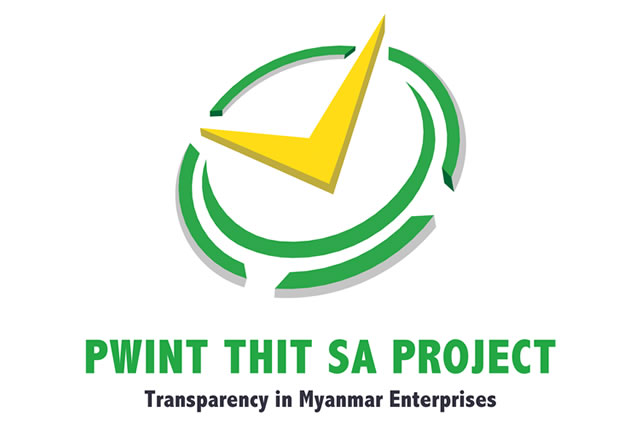UN FORUM SERIES - Encouraging transparency in Myanmar: Pwint Thit Sa

This article, by Vicky Bowman, Director of the Myanmar Centre for Responsible Business, was originally published as part of the London School of Economics' UN Forum Series.
The Myanmar Centre for Responsible Business (MCRB) recently released its second annual report on Transparency in Myanmar Enterprises (TiME), otherwise known as Pwint Thit Sa (which means “new buds opening” in Burmese).
The report surveys the websites – where they exist – of 100 of Myanmar’s largest companies. It was inspired by Transparency International’s Transparency in Corporate Reporting survey, and uses the same questions to measure the extent of published website information on corruption and organisational transparency.
However, TI’s report also has a focus on country-by-country tax reporting which is not relevant for Myanmar companies. Of more interest to all stakeholders is the approach that Myanmar companies take to human rights, land, HSE and stakeholder engagement. That was why we designed a third section focused on rating websites for their information on these issues.
In 2015 we included separate questions on whether the company’s website describes the existence of operational grievance mechanisms, and how they practiced stakeholder engagement, as well as what operations and assets they had, particularly land and how they managed its acquisition, as these were all points which had been raised as important by civil society stakeholders.
We compiled the questions for that section from a mixture of the US Reporting Requirements on Burma and the Global Reporting Initiative. We benefitted from inputs from MCRB’s parent organisations, the Institute for Human Rights and Business (IHRB), and the Danish Institute of Human Rights (DIHR) as well as Caroline Rees and Anna Triponel at SHIFT and their work on the Reporting and Assurance Framework Initiative (RAFI). Our aim was to put together a rubric which would be consistent with international standards, above all the United Nations Guiding Principles on Business and Human Rights (UNGPs), and both realistic and meaningful as a measure of company focus on these issues.
We recognise that, as with the methodology originally created by TI, the rating of companies based on their website claims is no guarantee of on the ground performance. For that reason, this year, we also sought out information on grievances against these companies from Myanmar civil society organisations to act as a reality check. As we received little such input, we also scanned the media for reports of human rights abuses by these companies – mostly relating to land or labour, and included them in annex to the report.
Overall we found an improvement amongst the best ten or so companies from last year who had published even more information that in 2014, particularly in this third section. For example, seven companies had published human rights policies, up from a couple the previous year.
We remain slightly concerned that companies are making promises that they do not keep in practice, which is why we look for opportunities to hold them to account on their public commitments and encourage others to do so. We also plan to raise the bar again next year to differentiate between those who simply say and those who prove they do.
The other challenge has been to engage the also-rans, particularly those companies who we would expect to be interested, not least as they are involved in joint ventures with OECD-listed companies who have presumably subjected them to some form of due diligence and follow up compliance training, particularly with regard to anticorruption. Part of the problem we observe is lack of skilled resources on the part of the companies to put in place systems both internally and for external communication. Many large Myanmar companies are turning to non-Myanmar employees for this, which has its own risks that what they advise is not going to be effectively embedded in company culture.
The 2014 TiME report was picked up with interest by those in the international community who wanted to know more about Myanmar’s companies, both businesses and governments, and the 2015 report has been no different. In meetings with MCRB, foreign investors and their consultants – and not only those from the West – were keen to know how actual or potential local partners performed on transparency, and whether they had in place commitments to business integrity, health, safety and environment (HSE) practices and respect for human rights.
Some Myanmar SMEs and joint ventures have also asked us if they can be a part of the report and use the competitive aspect to both spur their internal performance and publicise their leadership. We are working on a mini-Pwint Thit Sa version that allows companies to volunteer to be benchmarked by MCRB and then have the results published.
Pwint Thit Sa, with its focus on Myanmar companies, complements both the US State Department reporting requirements for US-owned investments which we believe have had a positive effect in encouraging transparency and peer to peer learning, as well as the Business and Human Rights Resource Centre’s Myanmar Foreign Investment Tracking Project, which encourages other foreign companies to proactively disclose details about their operations in Myanmar. All these initiatives should help to strengthen the underpinnings for corporate accountability here and we believe that other countries in the region would benefit from similar initiatives.
Read also
- 2022 Pwint Thit Sa / Transparency in Myanmar Enterprises
- uab Tops the 2020 Pwint Thit Sa / Transparency In Myanmar Enterprises Ranking
- 2020 Pwint Thit Sa / Transparency in Myanmar Enterprises
- Corporate Disclosure in Myanmar – Regulatory Requirements and Sustainability Leadership
- Disclosure of Company Information Leads to Better Business Reporting and a Better Investment Climate
 English
English မြန်မာ
မြန်မာ မြန်မာ (unicode)
မြန်မာ (unicode)








